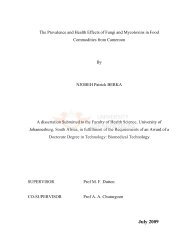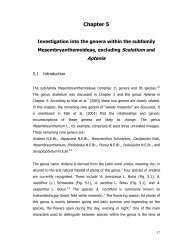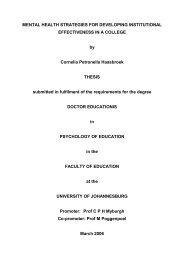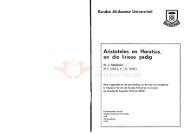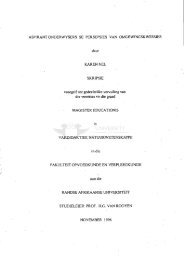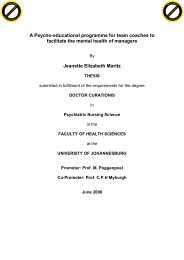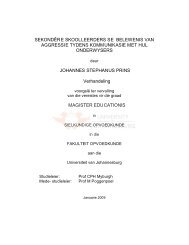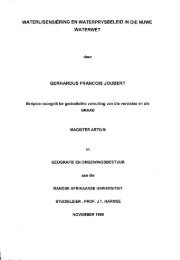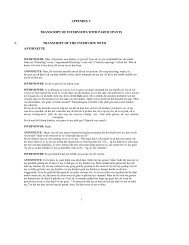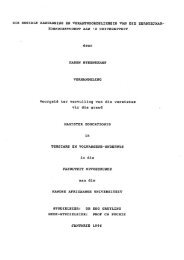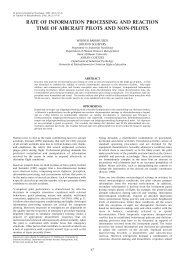Low-level laser therapy for diabetic foot wound healing.(Wound care)
Low-level laser therapy for diabetic foot wound healing.(Wound care)
Low-level laser therapy for diabetic foot wound healing.(Wound care)
You also want an ePaper? Increase the reach of your titles
YUMPU automatically turns print PDFs into web optimized ePapers that Google loves.
<strong>Low</strong>-<strong>level</strong> <strong>laser</strong> <strong>therapy</strong> <strong>for</strong> <strong>diabetic</strong> <strong>foot</strong> <strong>wound</strong> <strong>healing</strong>.(<strong>Wound</strong> <strong>care</strong>)<br />
Source: The Diabetic Foot<br />
Date: 12/22/2005<br />
Author: Houreld, Nicolette;Abrahamse, Heidi<br />
Introduction<br />
An alternative to traditional treatment modalities <strong>for</strong> <strong>diabetic</strong> ulcers is low-<strong>level</strong> <strong>laser</strong> <strong>therapy</strong><br />
(LLLT). A number of published studies demonstrate the beneficial effects of LLLT (Ribeiro et al,<br />
2002), although several other studies also exist which indicate results to the contrary (Malm and<br />
Lundeberg, 1991; Loevschall and Arenholt-Bindslev, 1994). Further work focusing on cellular and<br />
molecular mechanisms of responses to <strong>laser</strong> irradiation is required to establish LLLT as a<br />
reliable, safe and inexpensive treatment modality. This article reviews LLLT as a treatment<br />
modality <strong>for</strong> <strong>diabetic</strong> ulcers.<br />
KEY WORDS<br />
* <strong>Wound</strong> <strong>healing</strong><br />
* Laser <strong>therapy</strong><br />
* Photobiostimulation<br />
**********<br />
Due to its serious complications diabetes remains an important cause of morbidity and mortality.<br />
The principal complications arise from macro- and microangiopathy. The nervous system is also<br />
affected, which can lead to sensory loss and subsequent damage to the limbs. Atrophy of fat and<br />
muscle tissue, combined with sensory loss, can result in pressure sores on the feet, which, in<br />
turn, can lead to lower-limb amputation. Approximately 15% of people with diabetes will develop
<strong>foot</strong> ulcers, and 6% of these will require hospitalization <strong>for</strong> the treatment of such ulcers<br />
(Carrington et al, 2001). Diabetes accounts <strong>for</strong> 50% of all non-traumatic amputations (Schindl et<br />
al, 1998). Changes to the vascular system results in delayed <strong>wound</strong> <strong>healing</strong>. People with<br />
diabetes have poor circulation, poor resistance to infection, and poor local nutrition, thus these<br />
<strong>wound</strong>s are highly susceptible to infection.<br />
<strong>Low</strong>-<strong>level</strong> <strong>laser</strong> <strong>therapy</strong><br />
<strong>Low</strong>-<strong>level</strong> <strong>laser</strong> <strong>therapy</strong> (LLLT; also known as biostimulation and photobiostimulation) is a <strong>for</strong>m of<br />
photo<strong>therapy</strong> that involves the application of low-power monochromatic and coherent light to<br />
injuries and lesions in order to stimulate <strong>wound</strong> <strong>healing</strong>. LLLT has been shown to increase the<br />
speed, quality and tensile strength of tissue repair, resolve inflammation and provide pain relief<br />
(supporting literature is reviewed later in the article). Lasers are already used in a variety of<br />
medical and surgical fields, including dentistry, chiropractice, osteopathy, physio<strong>therapy</strong>,<br />
cosmetic, pain attenuation, <strong>wound</strong> <strong>healing</strong> and acupuncture to name but a few (e.g. Walsh,<br />
1997).<br />
The effects of LLLT are photochemical, not thermal, and the responses of cells occur due to<br />
changes in photoacceptor molecules (also known as chromophores [molecules which are able to<br />
absorb photonic energy]; Tuner and Hode, 2002), such as porphyrin. The exact mechanism of<br />
action of LLLT is not completely understood. However, it is known that during <strong>laser</strong> irradiation<br />
cells absorb photonic energy that is incorporated into chromophores, which, in turn, stimulates<br />
cellular metabolism (Pinheiro et al, 2002).<br />
The chromophore is able to transfer the absorbed energy to other molecules and thus cause<br />
chemical reactions in surrounding tissue. The acceptor molecules' kinetic energy is increased,<br />
thereby activating or deactivating enzymes, which, in turn, are able to alter the physical and/or<br />
chemical properties of other macromolecules (<strong>for</strong> example DNA and RNA; Matic et al, 2003;<br />
Takac and Stojanovic, 1998) in order to facilitate <strong>wound</strong> <strong>healing</strong>. Energy which is delivered to the<br />
cells produces insignificant and minimal temperature changes, typically in the range of 0.1-<br />
0.5[degrees]C (Nemeth, 1993).<br />
LLLT and <strong>wound</strong> <strong>healing</strong><br />
Normal <strong>wound</strong> <strong>healing</strong> requires both destructive and reparative processes in controlled balance.<br />
Proteases and growth factors play an important role in regulating this balance, and if disrupted in<br />
favour of degradation then delayed <strong>healing</strong> ensues, which is a trait of chronic <strong>wound</strong>s (Cullen et
al, 2002). It has been shown that low-<strong>level</strong> <strong>laser</strong> irradiation at certain fluences and wavelengths<br />
can enhance the release of growth factors and stimulate cell proliferation (Yu et al, 2001).<br />
The effects of LLLT include <strong>wound</strong> epithelialisation, reduction of oedema and inflammation, and<br />
re-establishment of arterial, venous and lymph microcirculation. Increased rates of ATP, RNA and<br />
DNA synthesis are also observed (Takac and Stojanovic, 1998). Major changes seen in <strong>wound</strong>s<br />
treated with LLLT include increased granulation tissue, early epithelialisation, increased fibroblast<br />
proliferation, increased extracellular matrix synthesis and enhanced neovascularisation (Walsh,<br />
1997), all of which lead to better tissue oxygenation and nutrition, and, in turn, enhanced <strong>wound</strong><br />
<strong>healing</strong>. The effects of LLLT on <strong>wound</strong> <strong>healing</strong> are summarised in Table 1.<br />
It has been shown that low-<strong>level</strong> irradiation of fibroblasts stimulates the production of basic<br />
fibroblast growth factor and stimulates the trans<strong>for</strong>mation of fibroblasts into myofibroblasts<br />
(Walsh, 1997). LLLT also affects immune cells, and acts directly and selectively on the immune<br />
system (Tadakuma, 1993). Stimulation of the immune system means that infected <strong>wound</strong>s can be<br />
cleared more readily. The use of low-<strong>level</strong> <strong>laser</strong>s in <strong>wound</strong> <strong>healing</strong> has been shown to speed up<br />
the <strong>healing</strong> of leg ulcers and burn <strong>wound</strong>s; it has also been shown to improve skin-<strong>healing</strong><br />
capabilities (Ribeiro et al, 2002).<br />
LLLT and <strong>wound</strong> <strong>healing</strong> in vitro<br />
It has been shown that exposure to a 308nm excimer <strong>laser</strong> reduces bacterial growth in vitro<br />
(Folwaczny et al, 1998). This may be of significant clinical importance in bacterially infected<br />
<strong>wound</strong>s: not only could LLLT increase <strong>wound</strong> closure, but it may also speed up the clearing of an<br />
infected <strong>wound</strong>--a definite benefit to people with diabetes.<br />
LLLT and <strong>diabetic</strong> <strong>wound</strong> <strong>healing</strong> in rodents<br />
Yu and colleagues (1997) evaluated whether low-<strong>level</strong> <strong>laser</strong> irradiation could improve <strong>wound</strong><br />
<strong>healing</strong> in mice with diabetes. Genetically <strong>diabetic</strong> mice (C57BL/KsJ-db/db) were exposed to an<br />
argon dye <strong>laser</strong> (wavelength: 630nm; power density: 20mW/[cm.sup.2] [see Table 2 <strong>for</strong><br />
definitions]). They demonstrated that <strong>laser</strong> irradiation enhanced <strong>wound</strong> closure over time;<br />
histological evaluation indicated improved <strong>wound</strong> epithelialisation, cellular content, granulation<br />
tissue <strong>for</strong>mation and collagen deposition as compared to the negative control group.<br />
LLLT has also been shown to enhance cutaneous <strong>wound</strong> tensile strength. Stadler and colleagues<br />
(2001) exposed the <strong>wound</strong>s of <strong>wound</strong>ed female C57BL/KsJ-db/db mice to low-<strong>level</strong> <strong>laser</strong>
irradiation and measured tensile strength. The <strong>wound</strong>ed mice were exposed to low-<strong>level</strong> <strong>laser</strong><br />
irradiation daily <strong>for</strong> 5 days, (wavelength: 830nm; power density: 79mW/[cm.sup.2]; energy<br />
density: 5.0J/[cm.sup.2] [see Table 2 <strong>for</strong> definitions]) starting either on the day of <strong>wound</strong>ing or 3<br />
days later. Compared with control mice (which received no irradiation) there was an increase in<br />
tensile strength in exposed mice sacrificed on days 11 and 23 post-injury. Higher tensile<br />
strengths were noted at 23 days in mice that received their course of irradiation 3 days after<br />
<strong>wound</strong>ing. Stadler and colleagues (2001) felt that further investigation of the mechanism of LLLT<br />
in primary <strong>wound</strong> <strong>healing</strong> is warranted.<br />
Reddy and colleagues (2001) concluded that photobiostimulation promotes tissue repair by<br />
accelerating the production of collagen and promotes overall connective tissue stability in <strong>wound</strong><br />
<strong>healing</strong>. Male rats with streptozotocin-induced diabetes received circular <strong>wound</strong>s 6mm in<br />
diameter either side of the spine--one <strong>wound</strong> was treated with a helium--neon (He--Ne) <strong>laser</strong><br />
(wavelength: 632.8nm; energy density: 1.0J/[cm.sup.2]) 5 days per week until there was <strong>wound</strong><br />
closure. The other <strong>wound</strong> received no <strong>laser</strong> irradiations and was used as the control. In 2003,<br />
Reddy compared these results with <strong>wound</strong>ed rats with streptozotocin-induced diabetes exposed<br />
to a gallium--arsenide (Ga--As) <strong>laser</strong> (wavelength: 904nm; energy density: 1.0J/[cm.sup.2]). The<br />
<strong>wound</strong> to the left of the spine was irradiated 5 days per week <strong>for</strong> a period of 3 weeks, while the<br />
<strong>wound</strong> to the right was used as a control. After 3 weeks, the rats were sacrificed and the <strong>wound</strong><br />
sites analysed (Reddy, 2003). Measurements of the He--Ne-irradiated <strong>wound</strong>s indicated there<br />
was an increase in maximum load, stress, strain, energy absorption and toughness compared<br />
with the controls (Reddy et al, 2001). There was an increase in tensile strength and toughness of<br />
the <strong>wound</strong> exposed to the Ga--As <strong>laser</strong> as compared with the control <strong>wound</strong>s. There were no<br />
changes in energy absorption between the control and irradiated <strong>wound</strong>s (Reddy, 2003).<br />
Biochemical analysis revealed that the amount of total collagen was significantly increased in<br />
<strong>laser</strong>-treated <strong>wound</strong>s over control <strong>wound</strong>s, with an increase in the concentration of acid- and saltsoluble<br />
collagen and insoluble collagen. There was also a decrease in proteolytic digestion as<br />
measured by a decrease in pepsin-soluble collagen (Reddy et al, 2001; Reddy, 2003). It is the<br />
opinion of Reddy (2003) that irradiation with an He--Ne <strong>laser</strong> <strong>for</strong> <strong>wound</strong> <strong>healing</strong> in mice with<br />
diabetes is better than irradiation with a Ga--As <strong>laser</strong>, and that the different biochemical<br />
responses may be wavelength and coherence dependent.<br />
LLLT and <strong>diabetic</strong> <strong>wound</strong> <strong>healing</strong> in humans<br />
Exposure to low-<strong>level</strong> <strong>laser</strong> irradiation abates the inflammatory reaction and stimulates the
immune system, leading to an increase in <strong>wound</strong> <strong>healing</strong> in infected <strong>wound</strong>s in people with<br />
diabetes (Khurshudian, 1989). Khurshudian treated 174 people with diabetes with suppurative<br />
diseases. Patients were exposed to a helium--cadmium <strong>laser</strong> beam of wavelength 441.6nm. A<br />
single exposure to 4.5J/[cm.sup.2] led to a rapid decrease in the inflammatory reaction, and there<br />
was a cleansing and acceleration of regeneration processes in the infected <strong>wound</strong>s.<br />
This was supported by work conducted by Kuliev and Babaev (1991). They studied the immune<br />
status after <strong>laser</strong> irradiation in 152 people with diabetes with purulent soft tissue injuries. There<br />
was a rapid stabilisation of the immune system, thus reducing the duration of treatment. Potinen<br />
(1992) determined the stabilisation of the immune system by the observation of the increased<br />
release of various cytokines upon LLLT. He also observed an increase in the leucocyte<br />
population and an arrest in bacterial growth.<br />
Kuliev and colleagues (1992) determined the effectiveness of including both a magnetic field<br />
(provided by various methods such as magnetic bracelets and wraps) and LLLT in the treatment<br />
of 119 people with diabetes with suppurative <strong>wound</strong>s. Immunological status was stabilised in a<br />
shorter time and the process of <strong>wound</strong> <strong>healing</strong> followed a quicker course, resulting in a shortened<br />
treatment time. It was suggested that the magnetic-<strong>laser</strong> combined effect has an advantage over<br />
the separate use of these factors.<br />
<strong>Low</strong>-<strong>level</strong> <strong>laser</strong> irradiation induces <strong>wound</strong> <strong>healing</strong> in conditions of reduced microcirculation.<br />
Schindl and colleagues investigated the effect of LLLT in patients with <strong>diabetic</strong> microangiopathy<br />
by infrared thermography on skin blood circulation (Schindl et al, 1998; Schindl et al, 2002). In the<br />
first study (Schindl et al, 1998), 30 people with <strong>diabetic</strong> ulcers or gangrene received either a<br />
single low-intensity <strong>laser</strong> irradiation (He--Ne <strong>laser</strong>; wavelength: 632.8nm; beam power: 30m/W;<br />
energy density: 30J/[cm.sup.2]), or a sham irradiation over both <strong>for</strong>e<strong>foot</strong> regions. At 20 minutes of<br />
<strong>laser</strong> irradiation, there was a significant rise in skin temperature in the <strong>for</strong>e<strong>foot</strong> area, with an<br />
increase of 0.58 [+ or -] 0.68[degrees]C (P
irradiation on one <strong>foot</strong> in people with diabetes with angiopathy causes a significant increase in<br />
skin circulation in both feet and points to the possibility of systemic effects.<br />
Schindl and colleagues (Schindl et al, 1999) conducted a study on a person with diabetes with<br />
sensory neuropathy, macroangiopathy and microangiopathy. The patient was exposed (in 16<br />
sessions within a 4-week period) to a 670nm diode <strong>laser</strong>, as well as conventional treatments<br />
(such as using dressings and antibiotics). There was complete <strong>healing</strong> of the ulcer with no<br />
recurrence after 9 months, despite the patient's unstable metabolic condition. Despite the fact<br />
that LLLT was not applied alone, LLLT may be a useful alternative treatment modality <strong>for</strong> the<br />
induction of <strong>wound</strong> <strong>healing</strong> of ulcers in people with diabetes which is free of side effects.<br />
Exposure of blood to LLLT results in a decrease in free radical oxidation (Grigor'eva et al, 1991).<br />
Grigor'eva and colleagues investigated the activity of primary and secondary products of lipid<br />
peroxidation and antiperoxide protection enzymes. The blood of 33 people with diabetes was<br />
irradiated <strong>for</strong> 60 minutes with the help of a light guide. After <strong>laser</strong> irradiation, there was a<br />
decrease in the activity of processes of free radical oxidation compared with blood samples taken<br />
be<strong>for</strong>e <strong>laser</strong> irradiations. This decrease is probably due to the effect of LLLT on antiperoxide<br />
enzymes. The group also found an increase in microcirculation, which is in accordance with the<br />
work of Schindl and colleagues (Schindl et al, 1998; 2002).<br />
Current literature<br />
Currently there is no accepted theory to explain the mechanism of low-<strong>level</strong> <strong>laser</strong> biostimulation,<br />
and this lack of knowledge complicates the evaluation of conflicting reports in the literature.<br />
Lasers have been shown to be both stimulatory and inhibitory. These differences in the literature<br />
can be explained by the different treatment parameters used, such as wavelength, fluence, output<br />
power and treatment regimens (Baxter et al, 1991). Few articles provide all the relevant <strong>laser</strong><br />
parameters, making it difficult to reproduce the work. Patient status, size and type of <strong>wound</strong> also<br />
play important roles. LLLT has been used extensively in <strong>for</strong>mer Eastern bloc countries, thus there<br />
is a vast amount of experience and in<strong>for</strong>mation available, although most of this work is published<br />
in Russian journals, and during the translation of these papers in<strong>for</strong>mation can become lost.<br />
According to the American Diabetes Association (1999), the following criteria should be included<br />
when evaluating new treatments <strong>for</strong> <strong>diabetic</strong> <strong>foot</strong> <strong>wound</strong> <strong>care</strong>: randomised controlled studies; a<br />
sufficient number of patients; relevant outcomes; control patients; primary end point, with a<br />
proportion of patients with complete <strong>wound</strong> <strong>healing</strong> within the study period; and evaluation of the
cost and effectiveness of the treatment and the quality of the patient's life. Of all the studies<br />
mentioned in this paper, none of them make mention of the costs and quality of patient life. The<br />
paper by Schindl and colleagues (1999) was written on a single patient.<br />
Conclusion<br />
The exploitation of photo<strong>therapy</strong> in medicine and surgery is of great interest, and there is a<br />
growing interest in the use of <strong>laser</strong>s <strong>for</strong> the treatment of various conditions and disorders,<br />
including the treatment of <strong>diabetic</strong> <strong>wound</strong>s. There is a need to develop alternative treatment<br />
modalities which can improve the endogenous capacity of the <strong>healing</strong> process, particularly during<br />
disease conditions with impaired <strong>wound</strong> <strong>healing</strong>. Using <strong>laser</strong>s as a source of photobiostimulation<br />
looks to be an attractive branch of medicine <strong>for</strong> the future.<br />
Chronic skin ulcers present a challenge in dermatology, and among the various non-invasive<br />
treatments used in <strong>wound</strong> <strong>healing</strong>, LLLT has steadily increased in its applications to include a<br />
wide variety of medical and surgical specialties (such as physiotherapists, dentists,<br />
dermatologists and rheumatologists, and also in nerve regeneration; Karu, 2003). LLLT as a<br />
treatment is a choice that appeals to people (Forney and Mauro, 1999), it is a simple and noninvasive<br />
treatment that offers pain relief and has no reported side effects. As outlined above,<br />
LLLT has been shown by various studies to be effective in the treatment of <strong>diabetic</strong> <strong>wound</strong><br />
<strong>healing</strong>.<br />
Due to disturbances of the circulation in people with diabetes, <strong>wound</strong>s heal slowly and are<br />
susceptible to infection. LLLT has been shown to speed up the time needed <strong>for</strong> <strong>wound</strong> closure in<br />
people with diabetes (Khurshudian, 1989; Kuliev and Babaev, 1991; Yu et al, 1997; Reddy et al,<br />
2001); and there is improved <strong>wound</strong> epithelialisation, increased cellular content, increased<br />
granulation tissue <strong>for</strong>mation and increased collagen deposition (Yu et al, 1997). There is a<br />
decrease in the inflammatory reaction (Khurshudian, 1989), and a stimulatory effect on the<br />
immune system (Khurshudian, 1989; Kuliev and Babaev, 1991). LLLT has also been shown to<br />
increase microcirculation (Grigor'eva et al, 1991; Schindl et al, 1998; Schindl et al, 1999; Schindl<br />
et al, 2002), enhance <strong>wound</strong> tensile strength (Stadler et al, 2001), accelerate collagen production<br />
(Reddy et al, 2001; Reddy, 2003), and decrease free radical oxidation processes (Grigor'eva et<br />
al, 1991) in people with diabetes.<br />
Due to the increasing cost of <strong>care</strong> of <strong>diabetic</strong> <strong>wound</strong>s, and the burden incurred by the patients<br />
and society, there is a need to develop new, inexpensive and safe treatment modalities which
increase <strong>wound</strong> <strong>healing</strong>. From the results of published studies on <strong>diabetic</strong> <strong>wound</strong> <strong>healing</strong>, large,<br />
properly controlled studies seem justified. At the correct wavelength, intensity and fluence, LLLT<br />
can be a complementary <strong>therapy</strong> modality in the treatment of impaired <strong>wound</strong> <strong>healing</strong> and future<br />
research should be developed to find adequate wavelengths and doses.<br />
American Diabetes Association (1999) Consensus development conference on <strong>diabetic</strong> <strong>foot</strong><br />
<strong>wound</strong> <strong>care</strong>. Diabetes Care 22(8): 1354-60<br />
Baxter GD, Bell AJ, Allen JM and Ravey J (1991) <strong>Low</strong> <strong>level</strong> <strong>laser</strong> <strong>therapy</strong>: Current clinical practice<br />
in Northern Ireland. Physio<strong>therapy</strong> 77(3): 171-8<br />
Carrington AL, Abbott CA, Griffiths J, Jackson N, Johnson SR, Kulkarni J et al (2001) A <strong>foot</strong> <strong>care</strong><br />
program <strong>for</strong> <strong>diabetic</strong> unilateral lower-limb amputees. Diabetes Care 24(2): 216-21<br />
Cullen B, Watt PW, Lundqvist C, Silcock D, Schmidt RJ, Bogan D, Light ND (2002) The role of<br />
oxidised regenerated cellulose/collagen in chronic <strong>wound</strong> repair and its potential mechanism of<br />
action. The International Journal of Biochemistry and Cell Biology 34(12): 1544-56<br />
Folwaczny M, Liesenhoff T, Lehn N, Horch HH (1998) Bactericidal action of 308 nm excimer-<strong>laser</strong><br />
radiation: an in vitro investigation. Journal of Endodontics 24(12): 781-5<br />
Forney R, Mauro T (1999) Using <strong>laser</strong>s in <strong>diabetic</strong> <strong>wound</strong> <strong>healing</strong>. Diabetes Technology and<br />
Therapeutics 1(2): 189-92<br />
Grigor'eva IV, Rakita DR, Garmash Vla (1991) [Effect of endovascular <strong>laser</strong> irradiation of the<br />
blood of patients with <strong>diabetic</strong> angiopathies.] Problemy Endokrinologii (Mosk) 37(6): 28-30<br />
Karu TI (2003) <strong>Low</strong> <strong>level</strong> <strong>laser</strong> <strong>therapy</strong>. In: T Vo-Dinh ed. Biomedical photonics handbook. CRC<br />
Press, Florida, USA, chapter 48: 1-25<br />
Khurshudian AG (1989) [Use of helium-cadmium <strong>laser</strong>s in the complex treatment of suppurative<br />
diseases in patients with diabetes mellitus.] Khirurgiia (Mosk) June(6): 38-42<br />
Kuliev RA, Babaev RF (1991) [Therapeutic action of <strong>laser</strong> irradiation and immunomodulators in<br />
purulent injuries of the soft tissues in <strong>diabetic</strong> patients.] Problemy Endokrinologii (Mosk) 37(6):<br />
31-2<br />
Kuliev RA, Babaev RF, Akhmedova LM, Ragimova AI (1992) Treatment of suppurative <strong>wound</strong>s in
patients with diabetes mellitus by magnetic field and <strong>laser</strong> irradiation. Khirurgiia (Mosk) July-<br />
August(7-8): 30-3<br />
Loevschall H, Arenholt-Bindslev D (1994) Effect of low <strong>level</strong> diode <strong>laser</strong> irradiation of human oral<br />
mucosa fibroblasts in vitro. Lasers in Surgery and Medicine 14(4): 347-54<br />
Malm M, Lundeberg T (1991) Effect of low power gallium arsenide <strong>laser</strong> on <strong>healing</strong> of venous<br />
ulcers. Scandinavian Journal of Plastic Reconstructive Surgery and Hand Surgery 25(3): 249-51<br />
Matic M, Lazetic B, Poljacki M, Duran V, Ivkov-Simic M (2003) [<strong>Low</strong> <strong>level</strong> <strong>laser</strong> irradiation and its<br />
effect on repair processes in the skin.] Medicinski Pregled 56(3-4): 137-41<br />
Nemeth AJ (1993) Lasers and <strong>wound</strong> <strong>healing</strong>. Dermatologic Clinics 11(4): 783-9<br />
Pearl SH, Kanat IO (1988) Diabetes and <strong>healing</strong>: a review of the literature. The Journal of Foot<br />
Surgery 27(3): 268-70<br />
Pinheiro AL, Carneiro NS, Vieira AL, Brugnera A Jr, Zanin FA, Barros RA, Silva PS (2002) Effects<br />
of low-<strong>level</strong> <strong>laser</strong> <strong>therapy</strong> on malignant cells: in vitro study. Journal of Clinical Laser Medicine and<br />
Surgery 20(1): 23-6<br />
Potinen PJ (1992) Biological effects of LLLT. In: PJ Potinen, ed. <strong>Low</strong> <strong>level</strong> <strong>laser</strong> <strong>therapy</strong> as a<br />
medical treatment modality. Art Urpo, Tampere, Finland, 99-101<br />
Reddy GK (2003) Comparison of the photostimulatory effects of visible He-Ne and infrared Ga-As<br />
<strong>laser</strong>s on <strong>healing</strong> impaired <strong>diabetic</strong> rat <strong>wound</strong>s. Lasers in Surgery and Medicine 33(5): 344-51<br />
Reddy GK, Stehno-Bittel L, Enwemeka CS (2001) Laser photostimulation accelerates <strong>wound</strong><br />
<strong>healing</strong> in <strong>diabetic</strong> rats. <strong>Wound</strong> Repair and Regeneration 9(3): 248-55<br />
Ribeiro MS, Silva DF, Maldonado EP, de Rossi W, Zezell DM (2002) Effects of 1047-nm<br />
neodymium <strong>laser</strong> radiation on skin <strong>wound</strong> <strong>healing</strong>. Journal of Clinical Laser Medicine & Surgery<br />
20(1): 37-40<br />
Schindl A, Heinze G, Schindl M, Pernerstorfer-Schon H, Schindl L (2002) Systemic effects of lowintensity<br />
<strong>laser</strong> irradiation on skin microcirculation in patients with <strong>diabetic</strong> microangiopathy.<br />
Microvascular Research 64(2): 240-6
Schindl A, Schindl M, Pernerstorfer-Schon H, Kerschan K, Knobler R, Schindl L (1999) Diabetic<br />
neuropathic <strong>foot</strong> ulcer: successful treatment by low-intensity <strong>laser</strong> <strong>therapy</strong>. Dermatology 198(3):<br />
314-6<br />
Schindl A, Schindl M, Schon H, Knobler R, Havelec L, Schindl L (1998) <strong>Low</strong>-intensity <strong>laser</strong><br />
irradiation improves skin circulation in patients with <strong>diabetic</strong> microangiopathy. Diabetes Care<br />
21(4): 580-4<br />
Stadler I, Lanzafame RJ, Evans R, Narayan V, Dailey B, Buehner N, Naim JO (2001) 830-nm<br />
irradiation increases the <strong>wound</strong> tensile strength in a <strong>diabetic</strong> murine model. Lasers in Surgery and<br />
Medicine 28(3): 220-6<br />
Tadakuma T (1993) [Possible application of the <strong>laser</strong> in immunobiology.] The Keio Journal of<br />
Medicine 42(4): 180-2<br />
Takac S, Stojanovic S (1998) [Diagnostic and biostimulating <strong>laser</strong>s.] Medicinski Pregled 51(5-6):<br />
245-9<br />
Tuner J, Hode L (2002) Laser <strong>therapy</strong>: Clinical practice and scientific background. Prima Books,<br />
Grangesburg, Sweden. 45-114<br />
Walsh LJ (1997) The current status of low <strong>level</strong> <strong>laser</strong> <strong>therapy</strong> in dentistry. Part I. Soft tissue<br />
applications. Australian Dental Journal 42(4): 247-54<br />
Yu W, Naim JO, Lanzafame RJ (1997) Effects of photostimulation on <strong>wound</strong> <strong>healing</strong> in <strong>diabetic</strong><br />
mice. Lasers in Surgery and Medicine 20(1): 56-63<br />
Nicolette Houreld is a Doctoral Student and Professor Heidi Abrahamse a Senior Research<br />
Fellow at The Laser Research Unit, Faculty of Health Sciences, Doornfontein, Johannesburg,<br />
South Africa.<br />
RELATED ARTICLE: ARTICLE POINTS<br />
1 <strong>Low</strong>-<strong>level</strong> <strong>laser</strong> <strong>therapy</strong> (LLLT) is an alternative treatment modality <strong>for</strong> <strong>diabetic</strong> <strong>wound</strong>s.<br />
2 LLLT increases the speed, quality and tensile strength of tissue repair, and also resolves<br />
inflammation and provides pain relief.
3 LLLT is a noninvasive treatment with no reported side effects.<br />
4 LLLT improves <strong>wound</strong> epithelialisation and increases cellular content, granulation tissue,<br />
collagen deposition and microcirculation.<br />
5 LLLT stimulates the immune system, enhances <strong>wound</strong> tensile strength and decreases free<br />
radical oxidation processes.<br />
RELATED ARTICLE: PAGE POINTS<br />
1 The use of low-<strong>level</strong> <strong>laser</strong>s in <strong>wound</strong> <strong>healing</strong> has been shown to speed up <strong>healing</strong> of leg ulcers<br />
and burn <strong>wound</strong>s; it has also been shown to improve skin-<strong>healing</strong> capabilities.<br />
2 It has been shown that exposure to a 308nm excimer <strong>laser</strong> reduces bacterial growth in vitro.<br />
RELATED ARTICLE: PAGE POINTS<br />
1 <strong>Low</strong>-<strong>level</strong> <strong>laser</strong> <strong>therapy</strong> has also been shown to enhance cutaneous <strong>wound</strong> tensile strength.<br />
2 Irradiation with an He--Ne <strong>laser</strong> <strong>for</strong> <strong>wound</strong> <strong>healing</strong> in mice with diabetes is better than irradiation<br />
with a Ga-As <strong>laser</strong>, and that the different biochemical responses may be wavelength and<br />
coherent dependent.<br />
RELATED ARTICLE: PAGE POINTS<br />
1 The magnetic-<strong>laser</strong> effect has an advantage over the separate use of these factors.<br />
2 Exposure of blood to LLLT has shown a decrease in free radical oxidation.<br />
3 LLLT as a treatment is a choice that appeals to people, it is a simple and non-invasive<br />
treatment that offers pain relief and has no reported side effects.<br />
4 Due to disturbances to circulation in people with diabetes, <strong>wound</strong>s heal slowly and are<br />
susceptible to infection.<br />
RELATED ARTICLE: PAGE POINTS<br />
1 Due to the increasing cost of <strong>care</strong> of <strong>diabetic</strong> <strong>wound</strong>s, and the burden incurred by the patients
and society, there is a need to develop new, inexpensive and safe treatment modalities, which<br />
increase <strong>wound</strong> <strong>healing</strong>.<br />
Table 1. Summary of events during <strong>wound</strong> <strong>healing</strong> and the effects of<br />
low-<strong>level</strong> <strong>laser</strong> <strong>therapy</strong> (LLLT; adapted from Pearl and Kanat, 1988).<br />
Phase Duration Events<br />
Lag 0-10 days Inflammation<br />
Clot <strong>for</strong>mation<br />
Epithelialisation<br />
Fibroblast migration<br />
Proliferation 2-4 weeks Mitogenesis<br />
Fibrinogenesis<br />
Cellular migration<br />
<strong>Wound</strong> contraction<br />
Angiogenesis<br />
Granulation tissue<br />
<strong>for</strong>mation<br />
Epithelialisation<br />
Remoulding [greater than or equal to]1 Scar <strong>for</strong>mation<br />
year Collagen maturation<br />
Collagen synthesis and<br />
lysis<br />
in balance<br />
Phase Effects of LLLT at all phases<br />
Lag Increased epithelialisation<br />
Re-establishment of arterial venous and lymph<br />
microcirculation<br />
Decreased oedema<br />
Pain attenuation<br />
Increased ATP, RNA and DNA synthesis<br />
Proliferation Increased granulation tissue<br />
Increased mitogenesis<br />
Increased neovascularisation<br />
Increased matrix synthesis<br />
Increased fibrinogenesis<br />
Decreased inflammation<br />
Increased cytokines and growth factors<br />
Increased stimulation of immune system<br />
Remoulding Increased tissue nutrition and oxygenation<br />
Increased <strong>wound</strong> closure<br />
Increased angiogenesis<br />
Increased tensile strength<br />
Table 2. Explanation of units used <strong>for</strong> LLLT.<br />
Power density refers to the light output per unit area of the target<br />
tissue being irradiated. This is measured in watts per square<br />
centimetre
(W/[cm.sup.2]) or milliwatts per square centimetre (mW/[cm.sup.2]).<br />
Energy density is equivalent to dose (or fluence) and is measured in<br />
joules per square centimetre (J/[cm.sup.2]). Energy density refers to<br />
the amount of energy per unit area brought to bear on the tissue being<br />
irradiated. It is measured using the following <strong>for</strong>mula.<br />
Energy density (D;J/[cm.sup.2]) = [power (W; watts) X<br />
time (s; seconds)]/[area treated ([cm.sup.2])]<br />
The wavelength of the <strong>laser</strong>s used is always measured in nanometres<br />
(nm).<br />
COPYRIGHT 2005 S.B. Communications<br />
This material is published under license from the publisher through the Gale Group, Farmington<br />
Hills, Michigan. All inquiries regarding rights should be directed to the Gale Group.<br />
Click here to see more articles on this topic.<br />
Try your research topic on HighBeam Research now (great <strong>for</strong> any business, educational or<br />
personal research need).<br />
About HighBeam Research<br />
HighBeam Research, Inc. (<strong>for</strong>merly Alacritude, LLC) operates an online research engine <strong>for</strong><br />
individuals, filling the gap between free search engines and high-end research services. By<br />
delivering sophisticated research tools with convenient access to the free Web, paid online<br />
services, and our proprietary Library database, we empower individual researchers to efficiently<br />
locate, organize and deliver answers. HighBeam Research is located at www.highbeam.com.<br />
HighBeam Research, Inc. © Copyright 2006. All rights reserved.



